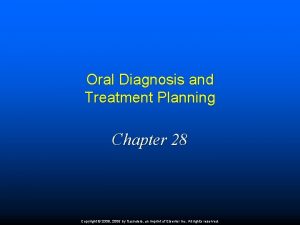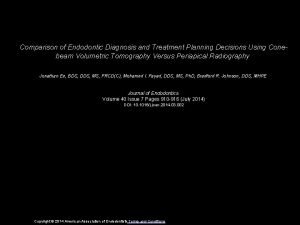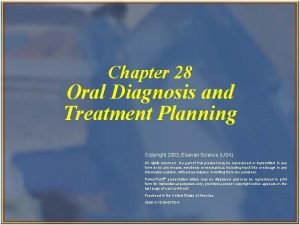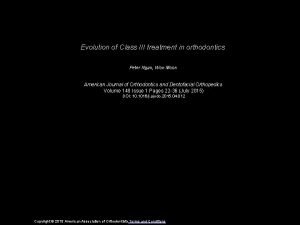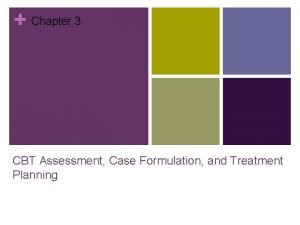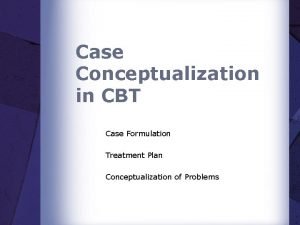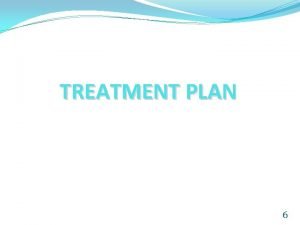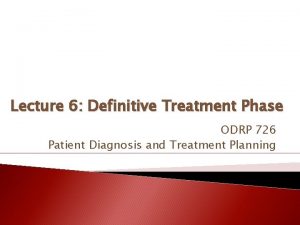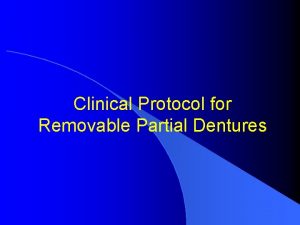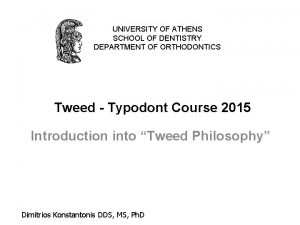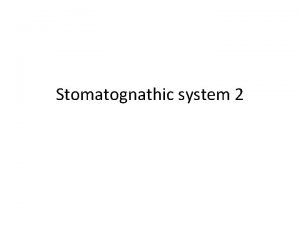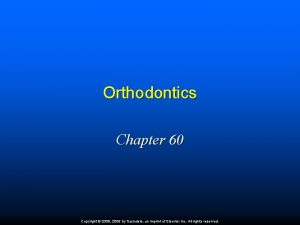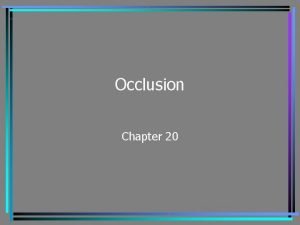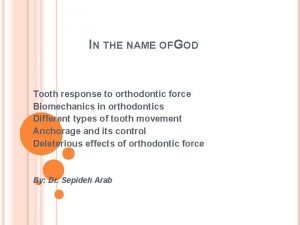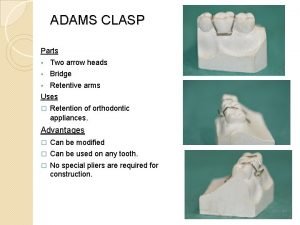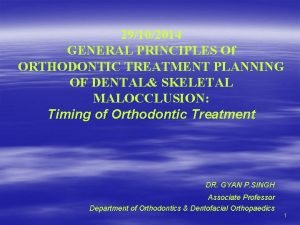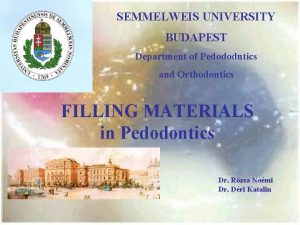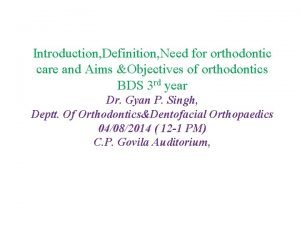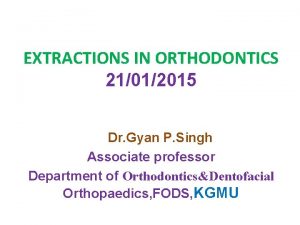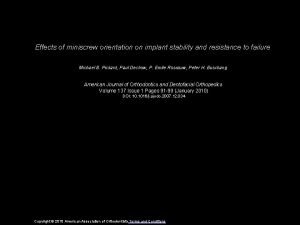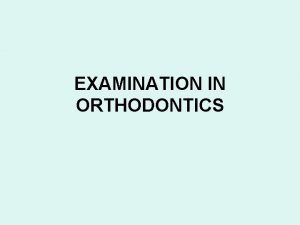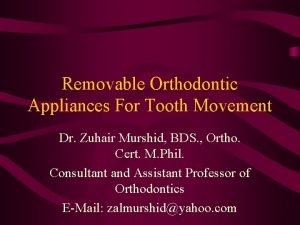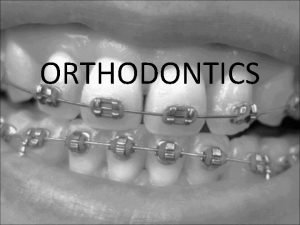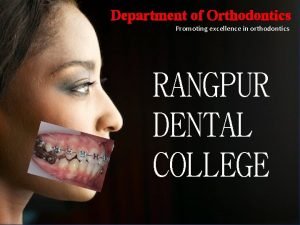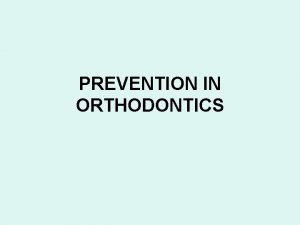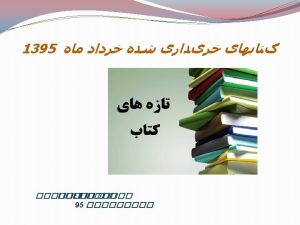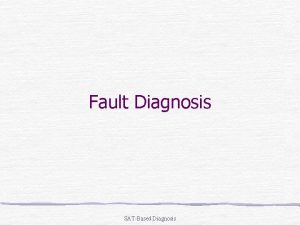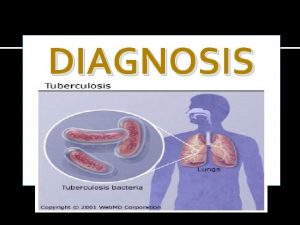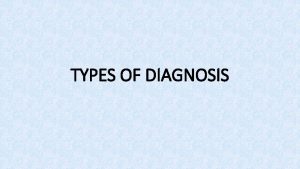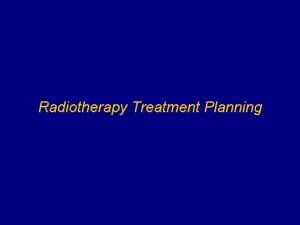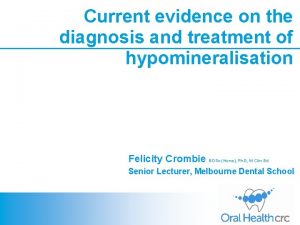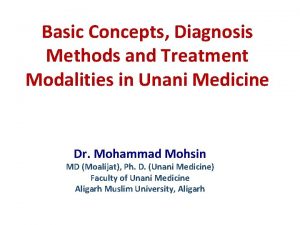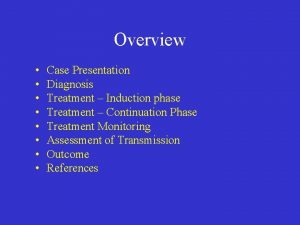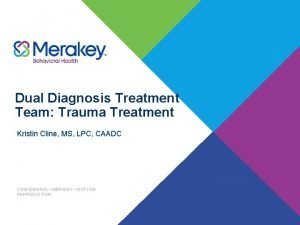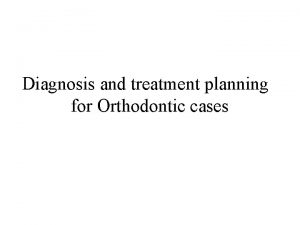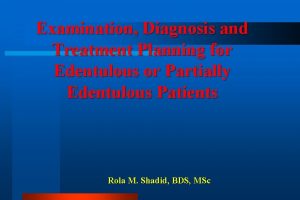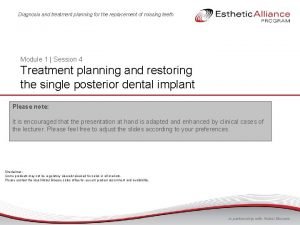Orthodontics Current Concepts in Diagnosis and Treatment Planning











































- Slides: 43

Orthodontics: Current Concepts in Diagnosis and Treatment Planning Dr shabeel pn

Questions that make ya go…. ’uhhhh’ Which teeth should be the main tooth in contact during function? CANINES What dimension of the face/head is the first to stop growing? Antero-Posterior? (Front to back) Width? (Side to Side) Vertical? (Length) At what age, when looking at a Panoramic Radiograph, if the 3 rd molars are not present will they not be there in the future? 15 Yrs If a tooth is missing or extracted at what age can they proceed with implant replacement? ~18 -19 girls, ~19 -20 boys What dimension of the face has to be completely done growing before the implant is placed? VERTICAL What X-Ray gives us growth information? HAND-WRIST

Orthodontist are Responsible for; • Monitoring growth and development • Correcting problems associated with growth and development – Syndromes – Down’s, Apert’s, Crouzon’s, Hemifacial Microsomia, etc – Cleft Lip and Palate – Congentially missing teeth – Jaw growth issues (genetic or environmental) – Eruption problems – Correcting functional relationships of the teeth – Improving Esthetics

PART I. Touching the Surface Orthodontics; Necessary or Not? Eruption timing of the teeth Defining Ideal GEOMETRIC Relationships of the permanent dentition (Lines/planes/angles) **All Patient Photos Used With Permission

PART II. What to look for… l l Age <6 Age 6 -8 Age 9 -11 Age 11 - Adult (primary) (early mixed) (late mixed-permanent)

Part III: Diagnosis and the Extraction/Non -Extraction Situation Depends on Time…. May start with this next time

Orthodontics; Necessary or Not? • Need to identify and inform if there is anything outside the envelope of ‘ideal’ alignment/function. • It is up to them to take the next step to seek out their options, but relieves you from responsibility of not informing them of the potential problems associated with a less-than ideal functional bite

What are the potential problems? • Abnormal Wear of the teeth – Abfraction/Abrasion • Failure of restored teeth/crowns/bridges

Abnormal Wear Abfraction Abrasion

What are the potential problems? • Abnormal Wear of the teeth – Abfraction/Abrasion • Failure of restored teeth/crowns/bridges • Loss of periodontal support • TM joint problems associated with abnormal jaw posturing during function

What are the potential problems? • Abnormal Wear of the teeth – Abfraction/Abrasion • Failure of restored teeth/crowns/bridges • Loss of periodontal support • TM joint problems associated with abnormal jaw posturing during function • Inability to clean teeth

Defining Ideal • Geometric tooth relationships – Static - at rest when all the teeth are in contact • Function – not able to touch this today – Dynamic – during chewing If we understand the IDEAL adult goal it will be easier to identify problems during growth

Geometric relationships (static) • Positive Overjet; Anterior and Posterior • Near Level Curve of Spee • Sufficient canine vertical overlap to ensure canine guidance • Overbite dictated by protrusive disclusion • Cusps of Molars on a PLANE


Midlines in good alignment

Overbite ~15% (1. 5 -2 mm), No black triangles at incisal embrasures

Angulation of the anterior teeth increases from the midline

Reasonably Level Curve of Spee

Angulation of Posterior segment near vertical from Buccal View

FACIAL PROPORTIONS and SOFT TISSUE SUPPORT

1/3 Upper Facial Height = Lower Facial Height

1/3 2/3 Upper Lip Length = ½ Lower Lip Length

A YOUTHFUL smile shows all of the upper incisor length (and some gingival tissue)

Lips touching a line connecting center nose to chin point

PART II. What to look for… l l Age <6 Age 6 -8 Age 9 -11 Age 11 - Adult (primary) (early mixed) (late mixed-permanent)

Age <6 (Primary Dentition) • Skeletal/Dental Class III • • – (Midface deficient/Mand excess) Crossbite Anterior/Posterior Functional shift Habits (tongue thrust/thumb sucking) Open bite • No space at age 5 -6 = Crowding 100% of the time

Age 6 -8 • Eruption of: – 1 st Molars • Dental-Class I, III Fact: If the molars are a full step Class II they will NOT correct to a class I – Central Incisors • Adequate room • Rotations/crossbite • Diastema – Lateral Incisors • Adequate room • Rotations/crossbite Result: Will have either • Class II Div 1 with increased Overjet, possible spacing Or • Class II Div 2 with maxillary crowding, deep bite and blocked out teeth

Class II, Div I • Gl’ Facial Angle (Glabella’-A’-Pg’) in a Class I profile is ~168 degrees. – with a reasonable variation • A’ Deficient Mandibular Body Length (She also has an advanced soft tissue A Point – due to flaring of incisors) • Pg’

Class II, Div I MB cusp of Maxillary 1 st molars in B Groove of Mandibular 1 st molars What is the most probable cause of the flaring and space?

Class II, Div I The Lower Lip

Class II, Div 2 Deep Bite Always Present Both arches tend to be crowded, with blocked out teeth

Age 6 -8 Continued • Width – Positive overjet in all dimensions – Anterior or posterior crossbites present? – Functional shifts? • Anterior-Posterior Jaw Relationships – Overjet (-/+) – Deficient Maxilla/Excessive Mandible (Skeletal-Class III) – Excessive Maxilla/Deficient Mandible (Skeletal-Class II) • Habits – Thumb/finger sucking, Tongue thrust

Age 7 Narrow Upper Arch 1. 5 mm diastema Crowding of laterals

AGE 7

Functional Shift - Lateral Shift to the Right • Lower midline off in the same direction as shift • Shift is ALWAYS to the crossbite side when unilateral crossbite present

Tongue Thrust

Age 9 -11 • Eruption of: – Mandibular canines (~age 9) • Space available – Max/Mand 1 st Premolars (~age 10) • Space available – Max/Mand 2 nd Premolars (~age 11 ) • E-Space!!! – very useful for uncrowding and correcting Molar class

E-Space 2 3 1 1 2 A B 3 C 4 D 5 6 4 E E- Space ~1. 3 mm/side 6

Age 11 -12 • Eruption of: – Maxillary canines • Space available • High Incidence of Impaction – 2 nd Molars • Impacted/Ectopic Eruption • Significant cause for functional interferences in adult dentition

Crowding/Blocked out Canines

Impacted Canines

Age 11 - Adult • Determine – – – Dental-Class (molars and canines) Skeletal-Class OJ/OB Alignment Space/Crowding Canine guidance (FUNCTION!!!)

Adult • Vertical Facial Development • • • – Excessive/deficient tooth display on smiling – Gummy smile Bite Tend to Deepen With Age (OB) Lower Anterior Crowding (not caused by 3 rds) Bruxism TMJ Disorders Interferences Third molar issues
 Chapter 28 oral diagnosis and treatment planning
Chapter 28 oral diagnosis and treatment planning House classification of denture patients
House classification of denture patients Endodontic diagnosis and treatment planning
Endodontic diagnosis and treatment planning Chapter 28 oral diagnosis and treatment planning
Chapter 28 oral diagnosis and treatment planning Evolution of class iii treatment in orthodontics
Evolution of class iii treatment in orthodontics Nursing diagnosis for community health
Nursing diagnosis for community health Medical diagnosis and nursing diagnosis difference
Medical diagnosis and nursing diagnosis difference Types of nursing diagnosis
Types of nursing diagnosis Nursing process and critical thinking
Nursing process and critical thinking Perbedaan diagnosis gizi dan diagnosis medis
Perbedaan diagnosis gizi dan diagnosis medis Line currents
Line currents Line vs phase voltage
Line vs phase voltage Semiconductor
Semiconductor Line current and phase current
Line current and phase current Drift current and diffusion current in semiconductor
Drift current and diffusion current in semiconductor Intrinsic semiconductor
Intrinsic semiconductor Line currents
Line currents Holding current and latching current
Holding current and latching current Diffusion current density
Diffusion current density Cbt case formulation
Cbt case formulation Case conceptualization example cbt
Case conceptualization example cbt The value of vgs that makes is approximately zero
The value of vgs that makes is approximately zero In alternators the welding current is produced on the ____.
In alternators the welding current is produced on the ____. Hazard based safety engineering
Hazard based safety engineering Kcl mesh analysis
Kcl mesh analysis Etiotropic phase
Etiotropic phase Advantages and disadvantages of rpd
Advantages and disadvantages of rpd Removable partial denture slideshare
Removable partial denture slideshare Site:slidetodoc.com
Site:slidetodoc.com Buccinator mechanism muscles
Buccinator mechanism muscles Chapter 60 orthodontics
Chapter 60 orthodontics Vertical
Vertical Optimum orthodontic force
Optimum orthodontic force Triangular clasp uses
Triangular clasp uses Jackson's triad orthodontics
Jackson's triad orthodontics Orthodontics semmelweis
Orthodontics semmelweis Mcq orthodontics
Mcq orthodontics Active stabilization in orthodontics
Active stabilization in orthodontics Mcq orthodontics
Mcq orthodontics Miniscrew in orthodontics
Miniscrew in orthodontics Nance serial extraction
Nance serial extraction Extraoral examination in orthodontics
Extraoral examination in orthodontics Component of removable orthodontic appliance
Component of removable orthodontic appliance Definition of orthodontics
Definition of orthodontics
